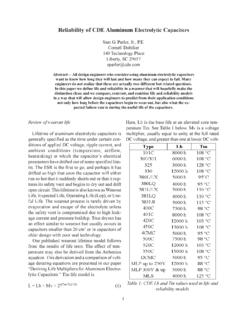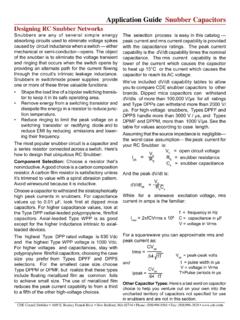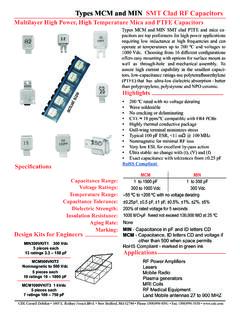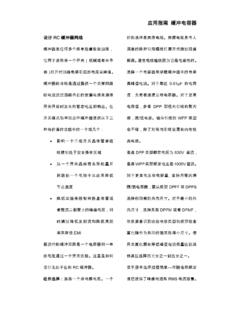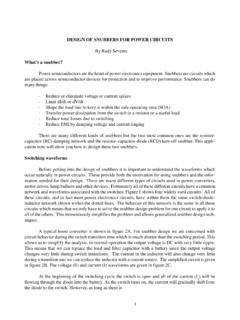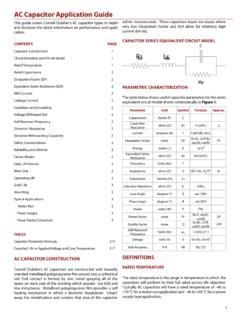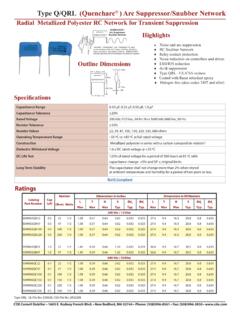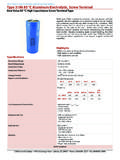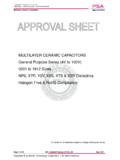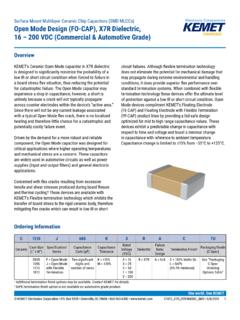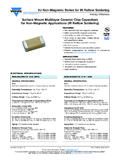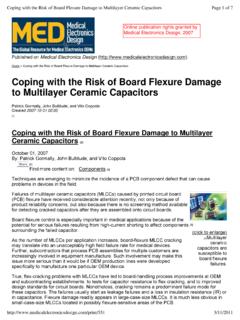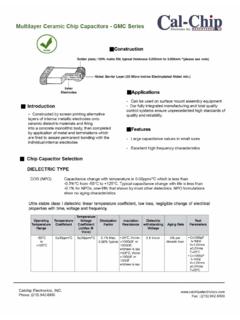Transcription of Multilayer Ceramic Capacitors - Performance …
1 Multilayer Ceramic Capacitors - Performance characteristics The EIA Standard for Ceramic dielectric Capacitors (RS-198C) divides into three classes. CDE Multilayer Ceramic Capacitors are available in the three most popular temperature characteristics : COG: Class I (Also known as 'NPO') Temperature Compensating Capacitors , suitable for resonant circuits where stable capacitance and high Q are necessary. They are made of non ferro-electric materials yielding superior stability and low volumetric efficiency. Parameter X7R: Class II Stable Capacitors , made of ferro-electric materials,yieldinghighervolumetriceffici ency but less are suitable for by-pass or coupling applications where stability and Q are not a major factor. COG (NPO) Z5U: Class III General Purpose Capacitors , suitable for bypass coupling where dielectric losses, high insulation resistance and stability are materials, Class III Capacitors have the lowest stability, but the highest volumetric efficiency.
2 X7R Z5U Temperature characteristics : Range, C:..-55 C to +125 C ..-55 C to +125 C ..+10 C to +85 C Capacitance change without DC voltage: ..0 30 PPM/ C * .. 15 %..+22 %, -56 % Aging Rate: % C / Decade Hour, Maximum:..0 %.. %.. % Dissipation Factor: Test Conditions @ 25 C: .. >1000 pF vrms @ 1 kHz..w/ vrms @ 1 kHz.. w/ vrms @ 1 kHz. 1000 pF vrms @ 1 MHz. Limits:.. % % % Insulation Resistance (IR): At rated voltage, whichever is smaller:.. 1000 megohms x 1000 megohms x 1000 megohms x F or 100 gigaohms or 100 gigaohms or 10 gigaohms Moisture Resistance: EIA RS-198C, Method B2, Condition A (10 cycles without applied voltage) Post test limits @ 25 C, whichever is smaller: .. 100 megohms x 100 megohms x 100 megohms x F or 10 gigaohms or 10 gigaohms or 1 gigaohm Immersion Cycling: EIA RS-198C Method D2, Condition A (2 cycles @ 15 minutes each. Each cycle consists of immersion in hot bath @ 65 C followed by immersion in cold tap water.)
3 Post test limits @ 25 C : Insulation Resistance, whichever is smaller:.. 100 megohms x 100 megohms x 100 megohms x F or 10 gigaohms or 10 gigaohms or 1 gigaohm Life Test: - 1000 Hrs. Test Potential and Temperature:.. 200 % V @ 125 % V @ 125 C ..150 % V @ 85 C Post test limits @ 25 C: Capacitance Change, whichever is greater:.. 2% or .. 20% of initial value**.. 30 % of initial value** Dissipation Factor:.. % Max.. % Max.. % Max. Insulation Resistance,whichever is smaller:.. 100 megohms x 100 megohms x 100 megohms x F or 10 gigaohms or 10 gigaohms or 1 gigaohm Dielectric Strength times rated voltage with current limited to 50 mA. * 60 PPM!C below 10pF nominal.** X7R and Z5U dielectrics exhibit aging characteristics ; therefore, it is +53 PPM -30 PPM/ C from +25 C to -55 C comparable to MIL-C-20 highly recommended that Capacitors be de-aged for 2 hours @ 150 C and stabilized at room temperature for 48 hours before capacitor measurements are made.
4 Effect of Applied Voltage +10 +5 0 -5 -10 4 3 2 1 1 10 100 AC DC DC AC PercentCapacitance ChangePercentDF 1 10 100 +20 PercentCapacitance ChangePercentDF 0 -20 -40 -60 4 3 2 1 AC DC DC AC AC or DC Volts Applied Typical Effect of 1000 Hz AC and DC Voltage Level on Capacitance and Dissipation Factor - X7R AC or DC Volts Applied Typical Effect of 1000 Hz AC and DC Voltage Level on Capacitance and Dissipation Factor - Z5U Note: COG Dielectric capacitance and dissipation factor are stable with voltage CDE Cornell Dubilier 1605 E. Rodney French Blvd. New Bedford, MA 02744 Phone: (508)996-8561 Fax: (508)996-3830 %DF%DF%DF%DF%DF% C% C% C% C% C% C% C% C% CImpedance vs. Frequency Multilayer Ceramic Capacitors - Performance characteristics Effect of Temperature + + 0 -55 -40 -20 0 20 40 60 80 100 125 % C +20 +10 0 -10 -20 -60 -40 -20 0 20 40 60 80 100 120 140 0 0 +20 0 -20 -40 -60 10080706050403020100 Temperature C Temperature C Temperature C Capacitance & DF vs.
5 Temperature - COG Capacitance & DF vs. Temperature - X7R Capacitance & DF vs. Temperature - Z5U %DF %DF %DF Impedance - OhmsImpedance - OhmsImpedance - Ohms% C % C % C % C % C 1K .01 F .001 F Frequency - MHz Impedance vs. Frequency for COG Dielectric F F F Effect of Time Capacitance100% 98% 96% X7R Z5U 94% 92% 90% 1K86% Frequency - MHz84% Impedance vs. Frequency for82% X7R Dielectric80% 78% 76% 74% 1 10 100 1000 10K 100K 1K F Typical Aging Rates for X7R and Z5U Effect of Frequency + + 0 100 1K 10K 100K 1M 10M %DF +5 +0 -5 -10 -15 100 1K 10K 100K 1M 10M 10 %DF Frequency - Hertz Frequency - Hertz Capacitance & DF vs. Frequency - COG Capacitance & DF vs. Frequency - X7R & Z5U % C % C % C % C Frequency - MHz Impedance vs. Frequency for Z5U Dielectric CDE Cornell Dubilier 1605 E. Rodney French Blvd. New Bedford, MA 02744 Phone: (508)996-8561 Fax: (508)996-3830
